First Look: Pyga Stage Max - Eurobike 2015
Patrick Morewood, the founder of Morewood Bikes now runs the Pyga brand out of South Africa. This more recent venture has a less gravity orientated attitude, concentrating more on short travel trail and cross country bikes. Available in their homeland as well as most of Europe and parts of Asia, the brand is looking to expand over the coming years.
Details
• Toray carbon fiber frame and rocker
• 29" wheels
• 126mm rear travel / 140mm fork
• 438mm chainstay length
• +FIVE chain line concept
• Sizes: M, L, XL
• Available early 2016
• Price: €5500 - €7900
• Toray carbon fiber frame and rocker
• 29" wheels
• 126mm rear travel / 140mm fork
• 438mm chainstay length
• +FIVE chain line concept
• Sizes: M, L, XL
• Available early 2016
• Price: €5500 - €7900
Here's the low-down from the man himself:
 | We're introducing the Stage Max for 2016. We have gone with a relatively long reach for a bike of this type - 450mm on a large, 67.5 head angle and 438mm chain stays with 29" wheels. Toray carbon frame, seat and chainstay,rocker, everything is full carbon. The frame weight on this is around 2.5kg's with the rear shock. Internal and external routing for all cables including a shock lock-out. It's just a really solid, all round bike that guys can take out on an all day ride, super efficient and comfortable. We have introduced a feature to the rear end called the +FIVE, because of the fact that bikes now have more gears than they were originally designed for. A 49mm chainline was developed around an 8/9 speed, now we're up to eleven and we have about 5mm out of chainline centre for the middle two gears. We found we were getting more chain wear and shifting in to the top gears was not as good as it should be. Instead of blaming component manufacturers we did something about it. We pushed the rear end of the bike across by 5mm, but kept everything standard like the 142mm hub and wheel, just the rim is dished 5mm towards the non-drive side. The benefits of this gives an almost symmetrical and therefore stronger rear wheel without the need to go to Boost 148. I race local enduros on it, and xc races. It's for the guy who just wants one bike for trail riding, maybe stage races and having fun. - Patrick Morewood, Pyga Bikes |
There is also a shorter travel bike called the Stage which has 95mm travel and recommended to be used with a 120mm fork. Patrick says South Africa is one of the biggest places in the world for stage racing and this is what this machine is aimed for.
Author Info:
Must Read This Week
Sign Up for the Pinkbike Newsletter - All the Biggest, Most Interesting Stories in your Inbox
PB Newsletter Signup
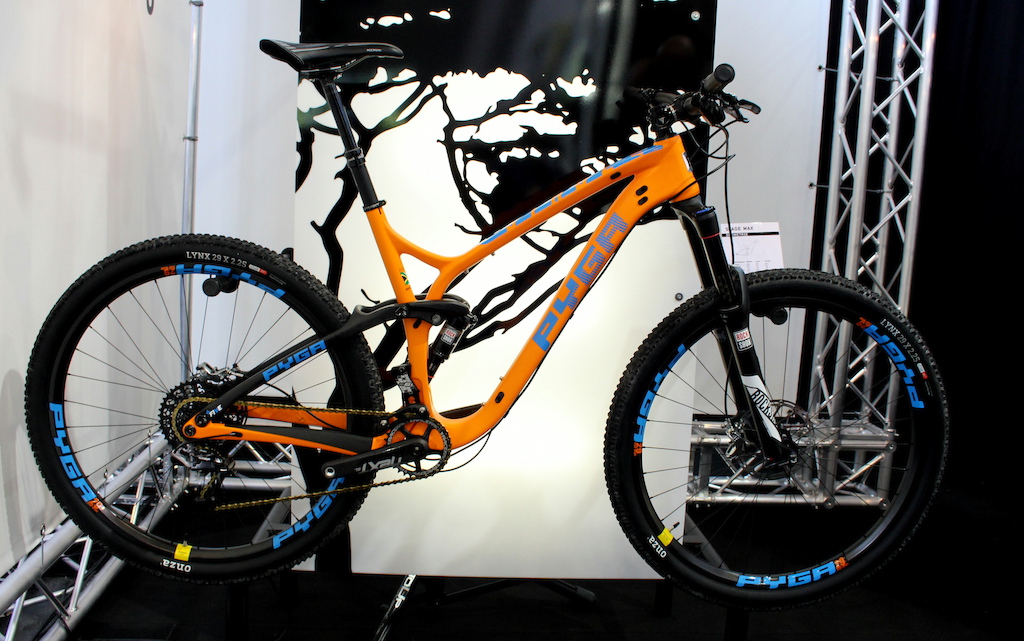
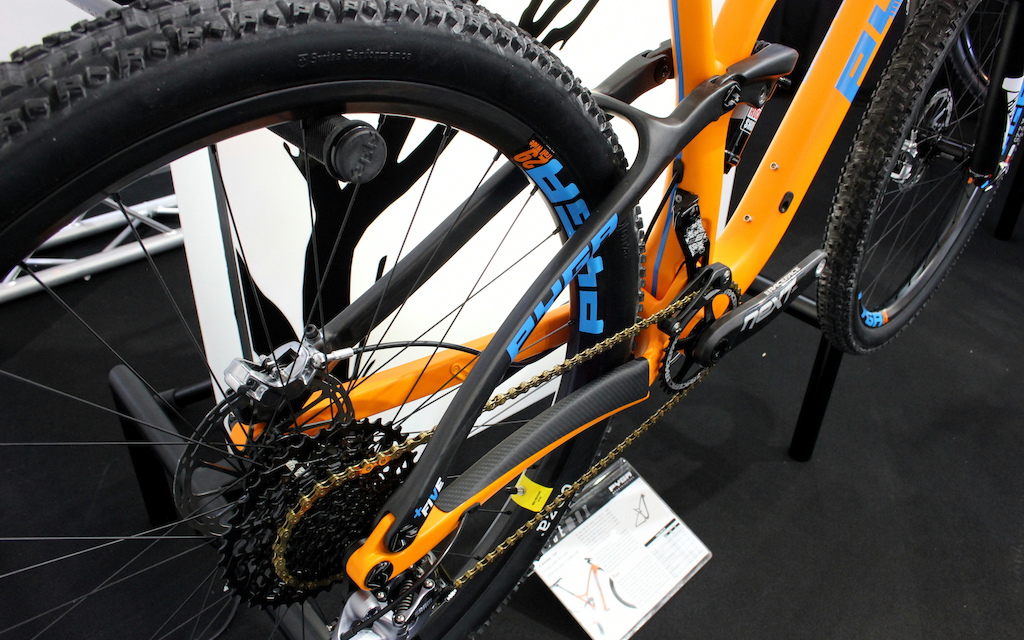
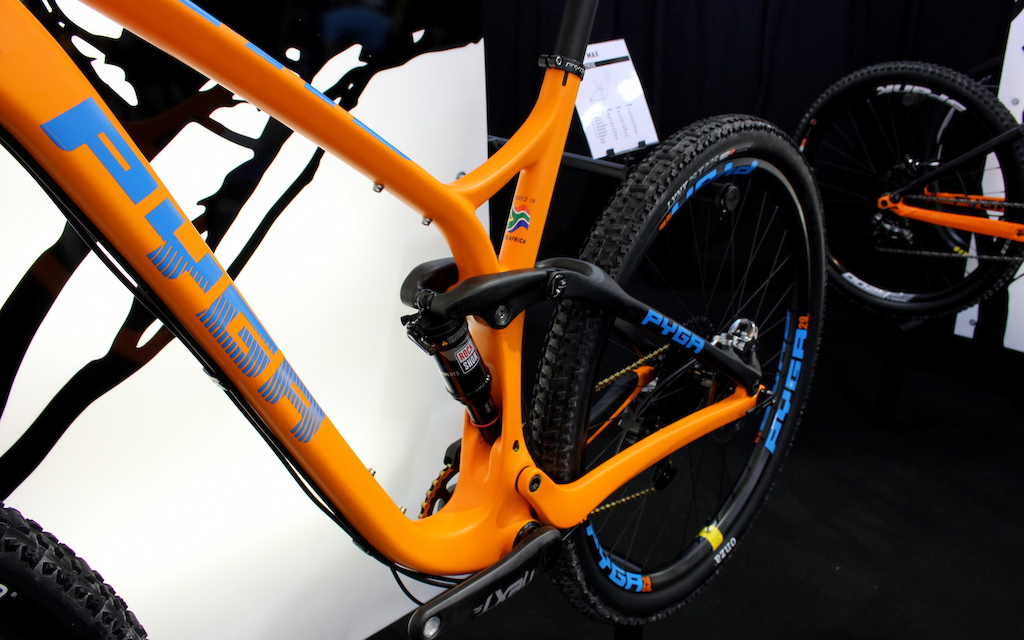
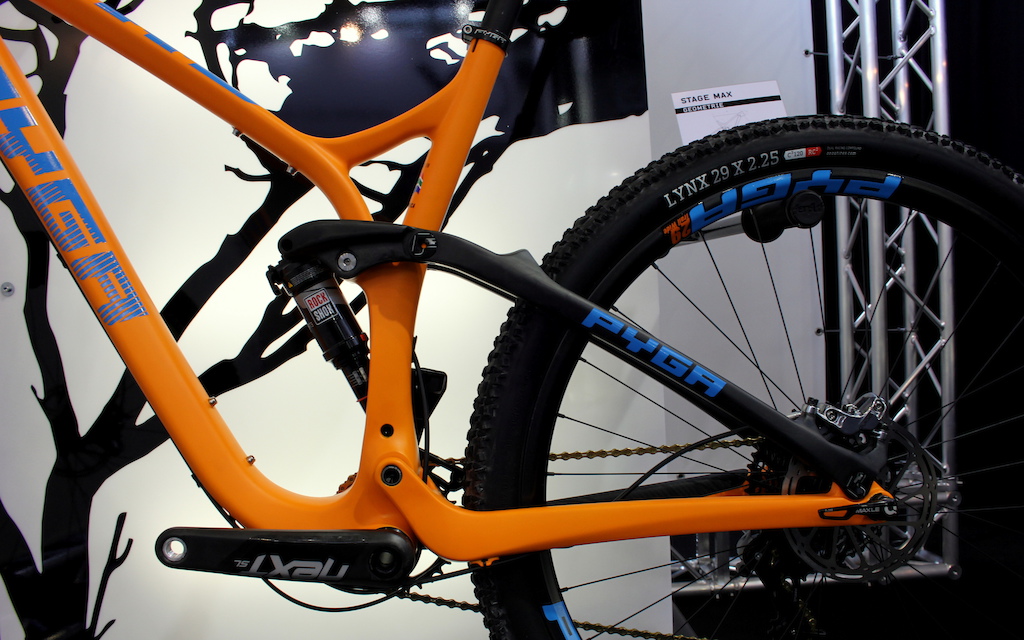
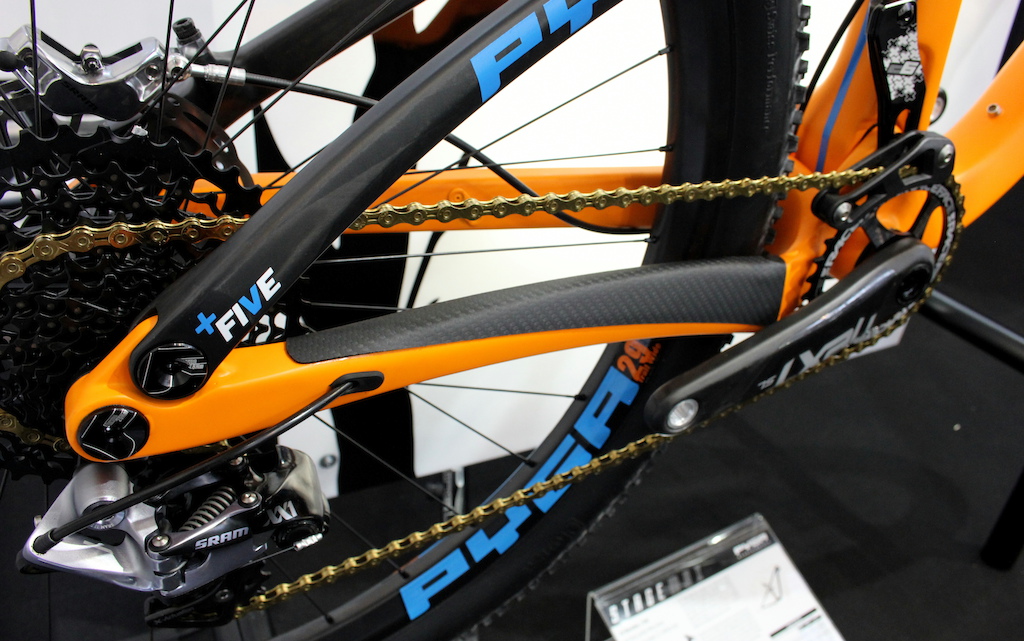



These guys get it.
actually braking affect the rear suspension less than most bikes with virtual pivot (Yeti, all DW bikes, Maestro etc)
This system is similar to a split pivot yes, but there is a fundamental difference. Split pivot was designed by someone who understands that a brake should be isolated from the suspension as much as possible in order for the system to work freely during braking. The Pyga system was designed by someone who thinks that your disc rotor should actually become an important structural part of your rear suspension system whenever you apply the brake. So that your damper can have a rest. Or something.
@russthedog, On this bike the caliper doesn't rotate with the rotor; as it sinks into travel it will compress the rotor and when it extends it will stretch the rotor.
Brake jack is fine as long as its not excessive,you do need to ride differently to horst though. Personally I'm faster with single pivots, even on dh. Dunno why?
I have a Pyga 110, with that exact brake position and it works extremely well. There is no brake feedback.
I have previously owned Giants, Treks, Spec Stumpjumpers etc etc. A mate of mine was raving about his Pyga. I reluctantly got off my Stumpie to have a go. I have NEVER got back on the Stumpie. This bike is amazing in terms of handling and fun. It is the sweetest bike I have ridden. I go faster and just can't stop grinning at the end of every run.
See international reviews:
bikemagic.com/gear/mtb-bike-reviews/pyga-oneten.html#PIBxoBJKYs24HgJ0.97
www.bikeradar.com/mtb/gear/category/frames/mountain-bike/product/review-pyga-industries-oneforty650-pascoe-14-48827
and if you google Pyga one will find many more excellent reviews with this braking system.
Its not arm chair engineering, its basic mechanics. Anyone who has ever played with mechanno can see in an instant that this design is plain stupid.
There IS brake feedback. I have tried one. It is horrendous, you can actually feel the rear end stiffen up when you apply the brake.
You bend your rotor...
For normal riding, this design isn't gonna be too problematic, you will prob just find yourself replacing rear rotors and pads slightly more often. If you repeatedly do long hard descents tho, your rear brake is gonna suffer mojor probs. Hence why I pointed out "no wonder they are moving away from the gravity market..."
Pyga's are winning all our local enduros.
I know of many people who have just completed Cape Epics, Joburg to Seas, etc on these Pygas - yes, among the hardest 8-9 day races in the world, and all their training (15-20 hours a week, for 6 months) - all on Pyga's with this brake design.
All love it, no one has ever spoken about brake feedback and no one has ever had a warping rear rotor.
But this twat reckons he knows better. Doos.
Please excuse my frankness, but I have never heard such rubbish before.
Just say you work for Specialized and we can get on with our lives.
Deflate your shock or remove the spring.
With the rear end at full extension, lock your brake on hard.
With the rear brake held on hard, sit on your seat and put weight on it. the suspension will compress, but not to full travel as with the brake locked on, the suspension will be semi locked out. Your disc rotor is now playing the role of the spring you removed. This is not a role it was designed for. This hopefully shouldn't damage your rotor. However if you do it the other way round (fully compress suspension/lock brake/allow spring to return sus to full travel) your rotor will be bent by the process as the caliper tries to crush the rotor towards the hub.
Hopefully you will now see what I am talking about.
Re-inflate (or spring) your shock.
Go ride.
Wince next time you overcook something and skid into some braking bumps with your rear wheel locked. Unless you believe your disc rotor is a viable alternative to a shock spring.
No other brake design suffers from this issue. All other designs will allow the rear suspension to move freely through its travel no matter what the rear brake is doing. Because they are designed by people who know what they are doing. Morewood has made a few bikes with pretty good geo. This really isn't hard/anything to be impressed by. There are very few bikes out there these days with bad geo.
This doesn't even touch on the fact that to work properly, your rotor and pads need to bed into each other. As the position of the pads migrates over the surface of the disc with this design, the pads and rotor won't ever bed in properly. If you would care to point out any advantages this design may offer over a proper floating caliper design (fsr/split pivot etc) please do. I am keen to see what the imagined point in this stupid design is. As far as I can tell there is absolutely no reason for it, other than dodging patents which have now expired anyway.
Anyone who has ever ridden this bike (incl reviews of magazines all over the world) know these bikes are just on point.
With the rear brake held on hard, sit on your seat and put weight on it. the suspension will compress, but not to full travel as with the brake locked on, the suspension will be semi locked out. Your disc rotor is now playing the role of the spring you removed. This is not a role it was designed for. No other brake design suffers from this issue. All other designs will allow the rear suspension to move freely through its travel no matter what the rear brake is doing.
Here is the best argument you guys have put forward:
Retard
&
I have ridden one, and I haven't had problems
I ride a Session. One of the old tinfoil downtube ones. I have put a couple of dents in it but no cracks. This doesn't mean a thicker walled downtube is not a good idea. However at least the thin walls allow for a stiff frame that is also light. The design has pro's and con's.
I have offered my description of the cons of the Pyga brake layout, but no-one has come up with any advantages it offers over a split pivot or fsr design. If someone can come up with one, I will accept it. However simply calling me a retard does little more than make me more confident that I am correct, as you can not come up with a real rebuttal. The Pygas work yes. But a Pyga with a split pivot or fsr design would work better. There is no reason not to use split pivot or fsr other than for patent dodging. Can anyone out there refute that?
I am merely arguing that if it were to have a detrimental impact on the ride of the bike, it simply wouldn't be there. I can't speak for Pat, but I do know him, and I know there will be a reason for it. I also don't think that just because he doesn't use fsr or split pivot, doesn't mean to say he is dodging patents. The whole range of PYGA bikes use the brakes mounted on the seatstay, bar the hardtail, and the reviews I've seen on the OneTwenty and the Pascoe have all been extremely positive, not only locally but internationally too. No mention of bent rotors, and if you can now tell me that those guys can't ride hard, well that is being a bit stubborn.
He was a pro downhiller himself; the guys who test the prototypes extensively, Mark Hopkins etc. all ride hard. Something like this wouldn't go unnoticed if it was going to be an issue.
Ride the bike, brake all you wish, and as per quoted in most reviews, you will find that the bike handles very well under braking.
I have one, I ride it often and very hard (100kg down monstrous hills). Compared to my previous Spec, Giants etc, it is fantastic.
Don't me to get my head out of my arse, you are the one telling me that if you clamp the inside and outside points of a disk, and turn them in line with the axis of the disk, it will warp / bend. Do you know the force required to do that, it is insane.
Get some decent disks mate.
www.bikeradar.com/mtb/gear/category/bikes/mountain-bikes/product/review-pyga-industries-oneten29-46488
www.bikeradar.com/mtb/gear/category/frames/mountain-bike/product/review-pyga-industries-oneten29-14-48762
www.attackmtb.com/ride-review-pyga-oneforty650
Thankyou. That was more like the response I had hoped for in the first place. Your comment has been +propped. One of the +s was from me. I know the situation I described (removing spring, sitting on bike etc) would never happen during normal use but some similar sort of situation could occur on the trail (screwing up really badly, overshooting a jump and landing flat with your rear brake locked in a desperate attempt to slow down before the next corner, or similar) Not often, but also not unheard of. When I tried to simulate similar occurrences by bouncing about on the bike with the brake locked, the rotor went from being dead straight to rubbing one of the pads occasionally when the wheel was turning. Not the end of the world I know, but not exactly what you want either. Especially if the design has no real advantages. You are right in saying the bike has definitely been tested by hard riders,better riders than me, and has good reviews, so clearly the system works well enough not to excessively hinder an otherwise good bike. I just cannot get my head round why they use the system at all when (at least in my opinion) an fsr or split pivot would work better. You say you know Pat. This is cool. If you ever see him and ask about it I would love to know his answer. I am well prepared to be shot down completely. Feel free to inbox me in future if you find out, I would be extremely grateful.
@Baracuda42
I know a good surgeon if you ever decide you need help removing your head from your arse. He's very discrete. Feel free to inbox me in future if you want his number.
We rode the course after all the weekend's racing had wrapped up, and even on the well-worn braking bumps the PYGA's rear wheel was surprisingly planted. Moreover, the unique rear brake setup – the caliper is mounted to the seat stays despite having pivots located above the rear dropouts – provides a slight floating arrangement that keeps the rear end from locking up when the pads are engaged.
"I wanted to design a bike that could provide an active suspension under braking, but it needed to be single-pivot without infringing on any patents," Morewood said. "I found that by placing the pivot as close to the rear axle as possible I could achieve this. It doesn't give the same braking anti-squat that other brands have, but there is another small benefit: the pads move up and down slightly on the disc rotor, preventing grooves from wearing into the pads or rotor."
"small benefit: the pads move up and down slightly on the disc rotor, preventing grooves from wearing into the pads or rotor."
Cool. I have been looking for an explanation like this for a long time. Have my own reservations about the pad/rotor wear thing, but at least I know Pats official stance now. Cheers man!
I have a bit more info for you from one of my local forums, that may settle your concerns a bit more than what's been said here...
Hey Guys,
Just want to provide some insight into the whole braking discussion. Below are graphs created by the owner of Linkage, a linkage program used by the vast majority of bike designs, providing accurate information.
"Anti-rise" is worked out as a percentage and relates to how much the suspension will or will not compress under braking. The higher the percentage of Anti-Rise, the stiffer and less responsive your suspension will be under braking. Leading to the feeling of 'Brake Jack' and more rear wheel chatter under braking. You will notice the conventional single pivot design (Sesta) has around a 90% anti-rise, and the horst link and VPP linkages are in the 60% range. Generally in a good design one will notice a lower percentage in downhill bikes due to extreme terrain conditions, accompanied by a much more progressive leverage curve. For XC and Trail bikes these parameters will change accordingly.
On the PYGA braking system the brake pads will move up and down on the rotor by aprox 2-3mm. It is much easier for the pad to move up and down on the rotor, than the rotational force of the pads against the rotor. Therefore the up and down movement is not noticable (while riding). A static test will not give an accurate representation of how it reacts while riding, and will simply flex the rotor to the left. This does not happen when the wheel is rotating. Besides this, it will almost never occur that the brake is locked by the time the suspension is fully compressed. (In four years of using this design, PYGA have never experienced any shortcomings from this design, nor comebacks. Only compliments)
PYGA Stage - Single Pivot - Starts at 54%, ending on 72%
Specialized Stumpjumper 2016 - Horst Link - starts at 62%, ends at 68%
Sesta - Single Pivot - Starts at 94%, ends at 86%
Below is an explanation from the Linkage programs designer, about his thoughts on the PYGA Stage. He has never seen the bike in flesh or hasn't ridden it, it is just how he has interpreted the data from the graphs.
"As you can see in the excel table and the first graphics system has a very high pedalling efficiency, with percentages of Anti-squat between 100% & 135% with a transmission type 1x11. The system is also compatible with a type 2x10 or 3x10 transmission and in theory will work perfectly without any kind of lock, but still in PYGA have decided to mount an RS Monarch XX locking knob from the handlebar, I think this configuration is intended for use in competition, but in day to day the system can function perfectly well without this accessory. The Pedal-kickback (10.5 deg) not surprisingly is at a high level, while the brake squat (53%) remains at a very low level, since the system works more or less like an FSR...
In the graph of Leverage Ratio see how the system is progressive (2.45~2.0) a rather unusual figure for a picture with 95mm of travel and so sait at first that this table is quite versatile for travel may seem a box 100% competition, but then the system will be very comfortable, so this is ideal for hiking weekend box in this respect is a bit like the Canyon lux, the DeVinci Atlas or Anthem Giant 29"... Pictures with a high pedalling efficiency but with a system that also takes into account the comfort"
Please excuse the grammar - it seems as if some was google translated incorrectly at one point.
I have also uploaded the pics to my profile, if you want to see them.
Link to original text: www.bikehub.co.za/forum/topic/153657-pyga-rear-braking-system/?p=2702809
So you also get to learn a foreign language on this forum!
Doos is just "c*nt"
www.youtube.com/watch?v=yBJPLY4xukU
I have a Pyga 110, with that exact brake position and it works extremely well. There is no brake feedback.
I have previously owned Giants, Treks, Spec Stumpjumpers etc etc. A mate of mine was raving about his Pyga. I reluctantly got off my Stumpie to have a go. I have NEVER got back on the Stumpie. This bike is amazing in terms of handling and fun. It is the sweetest bike I have ridden. I go faster and just can't stop grinning at the end of every run.
See international reviews:
bikemagic.com/gear/mtb-bike-reviews/pyga-oneten.html#PIBxoBJKYs24HgJ0.97
www.bikeradar.com/mtb/gear/category/frames/mountain-bike/product/review-pyga-industries-oneforty650-pascoe-14-48827
But this bike does look like it's a whole lotta fun driving it and you'll look good while doing so!